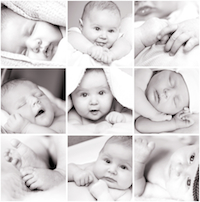 Baby pictures have a nearly universal “human touch” appeal. On the social media scale of cuteness, engagement and share-ability, babies, kids and grandkids are right up there in popularity with images of “grumpy cat,” playful puppy dogs, and ice bucket videos.
Baby pictures have a nearly universal “human touch” appeal. On the social media scale of cuteness, engagement and share-ability, babies, kids and grandkids are right up there in popularity with images of “grumpy cat,” playful puppy dogs, and ice bucket videos.
 Baby pictures have a nearly universal “human touch” appeal. On the social media scale of cuteness, engagement and share-ability, babies, kids and grandkids are right up there in popularity with images of “grumpy cat,” playful puppy dogs, and ice bucket videos.
Baby pictures have a nearly universal “human touch” appeal. On the social media scale of cuteness, engagement and share-ability, babies, kids and grandkids are right up there in popularity with images of “grumpy cat,” playful puppy dogs, and ice bucket videos.
But evidently “cute” has its limits when baby pictures are publically posted—as they commonly are—in doctors’ offices. “The “baby wall” at obstetricians’ and midwives’ offices is gradually going the way of cigars in the waiting room,” reports The New York Times, “because of the federal patient privacy law known as HIPAA.”
Provisions of the federal Health Insurance Portability and Accountability Act of 1996 are intended to protect confidentiality and security of healthcare information. And as silly as this story sounds, it seems that HIPAA, has no sense of humor. In fact, the Times headline says baby pictures at the doctor’s office are: “Cute, Sure, but Illegal.”
You’ve got to be kidding, right? Well…no.
We’re not offering legal advice here, but we’ve heard reactions to this HIPAA interpretation ranging from “unintended consequences” to “ridiculous” and “silly, silly, silly.” Parents commonly submit “new baby” pictures, and no violations or complaints were reported in the Times article.
Neverthelesss, “Pictures of smiling babies crowd a bulletin board in a doctor’s office in Midtown Manhattan, in a collage familiar to anyone who has given birth,” according to the Times article. “But the women coming in to have babies of their own cannot see them. They have been moved to a private part of the office, replaced in the corridors with abstract art.
“Under the law…baby photos are a type of protected health information, no less than a medical chart, birth date or Social Security number, according to the Department of Health and Human Services. Even if a parent sends in the photo, it is considered private unless the parent also sends written authorization for posting, which almost no one does.”
If you have a concern about this in your office, you’ll want to check with the compliance officer or your legal counsel. And since we’re not attorneys, we asked our friend, Kathleen Juniper—an experienced health care attorney Of Counsel at the BuchalterNemer firm—for her reaction.
Endearing and adorable don’t tip the legal scales with privacy. “I have to agree with the government for the most part, on this one,” Kathleen told us. “Authorization is necessary where disclosure is made to the public, where the clinic/doctor takes the photo, or a photo is sent in for a purpose related to the baby’s health care. Even though there are no names attached to the photos [presumably], someone could nonetheless identify a baby and subsequently disclose the information publicly.”
One solution might be to reference “baby pictures” as a matter of the doctor or clinic’s policy, and include particulars in the HIPAA Notice of Privacy Practices. And even then, the issue may not be entirely clear-cut. What about Christmas cards sent from the parents that include baby or family and are commonly displayed in the clinic?
If you have a question about the permissible use of photos in medical marketing—baby pictures or otherwise—the safe course is to check with your attorney. Situations and particulars can vary, but the use of photos in advertising, marketing or similar public display, are traditionally covered by specific, written permission, usually in the form of a photo or model release form.
The Times article points to several professional offices where, baby boards and pictures have been removed. This interpretation of the regulations may or may not be up to a legal test, but doctors’ offices seem to be “playing it safe” and replacing baby pictures with inoffensive, and emotionally neutral, artwork.
We’d love to hear what you think? Is this an issue in your office?








